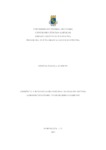Por favor, use este identificador para citar o enlazar este ítem:
http://www.alice.cnptia.embrapa.br/alice/handle/doc/953221| Título: | Ambiência e bem-estar de ovelhas criadas em sistema agrossilvipastoril no semiárido cearense. |
| Autor: | BRITO, I. F. de  |
| Afiliación: | Ismênia França de Brito. |
| Año: | 2012 |
| Referencia: | 2012. |
| Descripción: | Resumo: Objetivou-se estabelecer os parâmetros fisiológicos de ovelhas criadas em sistema agrossilvipastoril no Semiárido Nordestino e, consequentemente, avaliar as condições ambientais oferecidas aos animais por esse sistema de criação. Assim, foram selecionadas 22 ovelhas mestiças, avaliadas durante as épocas seca e chuvosa, quanto aos seguintes parâmetros fisiológicos: frequência cardíaca (FC); frequência respiratória (FR); temperatura superficial (TS) e temperatura retal (TR), durante os turnos da manhã e tarde. Seis miniestações meteorológicas e Data Loggers foram utilizadas para o registro dos dados de temperatura e umidade relativa do ar. Foi calculado o Índice Entalpia de Conforto (IEC) para a avaliação do conforto térmico. Foi possível observar que a temperatura mostrou-se mais elevada no período seco em comparação ao período chuvoso; que a FR apresentou diferença significativa (P<0,05) entre os turnos da manhã e da tarde no período chuvoso. Foi observada diferença estatística (p<0,05) para a FC tanto entre as épocas seca e chuvosa, quanto entre os turnos manhã e tarde. Quanto à TS, esta apresentou diferença (p<0,05) entre os turnos da manhã e tarde e entre as épocas seca e chuvosa. Para TR, os dados mostraram que não houve diferença estatística (p>0,05) para o turno da tarde, entre as duas épocas avaliadas. Foi monitorada ainda a conduta sexual dos animais e, por meio de um etograma, foram avaliados os seguintes parâmetros: proximidade ao macho (PM); micção (M); cheira o macho (CM); lambe o macho (LM); monta no macho (MM); mantém-se imóvel com o macho cheirando (IMC); abana/levanta a cauda (ALC); monta nas fêmeas (MF); deixa-se montar pelas fêmeas (DMF) e aceita a monta (AM). Observou-se que PM, M, IMC, CM e ALC apresentaram uma relação significativa (p < 0,05) com a aceitação da monta. A demonstração da conduta sexual das fêmeas estudadas não foi afetada pelos parâmetros climáticos. As temperaturas retais foram de 38,1 ºC para as fêmeas que apresentaram estro no turno da manhã e 38,7 ºC para as do turno da tarde. Os animais apresentaram comportamento sexual normal de ovelhas em estro e a temperatura retal das ovelhas se manteve dentro da normalidade. De forma geral, o sistema agrossilvipastoril avaliado nesta pesquisa assegurou condições favoráveis de conforto térmico e bem estar aos animais. Abstract: This study aimed to establish the physiological parameters of ewes reared in agrosilvopasture system in the northeast semiarid and hence assess environmental conditions offered by the system. Thus, 22 crossbred ewes were selected and evaluated during the dry and rainy seasons, considering the following physiological parameters: heart rate (HR), respiratory rate (RR), surface temperature (ST) and rectal temperature (RT) during shifts morning and afternoon. Six mini-stations and meteorological Data Loggers were used to record the data of temperature and relative humidity. It was calculated the Enthalpy Index of Comfort (EIC) for evaluating the thermal comfort. It was observed that the temperature was higher in the dry season compared to the rainy season and the RR presented significant difference (P <0.05) between the morning and afternoon during the rainy season. Statistical difference was observed (p <0.05) for both HR between the dry and rainy seasons, as between morning and afternoon shifts. As for the ST, a significant difference (p <0.05) was detected between the morning and afternoon and between the dry and rainy seasons. For TR, the data showed no statistical difference (p> 0.05) for the afternoon shift, between the two periods evaluated. The sexual behavior of animals was also monitored and, through an ethogram, the following parameters were evaluated: proximity to male (PM); urination (U); smells the male (SM); licks the male (LM); mounts the male (MM); remains immobile with the male sniffing (RIMS); wags/raises the tail (W/RT); mounts the females (MF); allows to assemble by females (AAF) and accepts the mount (AM). It was observed that PM, U, RIMS, SM and WRT showed a significant relationship (p <0.05) with acceptance of mount. The demonstration of the sexual conduct of females studied was not affected by the climatic parameters. The rectal temperatures were 38.1 °C for females that showed estrus during the morning and 38.7 ºC for the afternoon shift. The animals showed normal sexual behavior in estrus and the rectal temperature of ewes remained in the normal limits. Overall, the system agrosilvopastoral evaluated in this study ensured favorable conditions for thermal comfort and well being of the animals. |
| Thesagro: | Ovino Fisiologia animal Comportamento sexual Stress |
| Palabras clave: | Conforto térmico Sistema agrossilvipastoril Semiárido Estresse |
| Notas: | Dissertação (Mestrado em Zootecnia) Universidade Federal do Ceará, Fortaleza. Orientador: José Antonio Delfino Barbosa Filho; Co-orientador: Alice Andrioli Pinheiro (Embrapa Caprinos e Ovinos). |
| Tipo de Material: | Teses |
| Acceso: | openAccess |
| Aparece en las colecciones: | Tese/dissertação (CNPC)  |
Ficheros en este ítem:
| Fichero | Descripción | Tamaño | Formato | |
|---|---|---|---|---|
| UPAAmbienciaebemestar.pdf | 952.45 kB | Adobe PDF |  Visualizar/Abrir |









